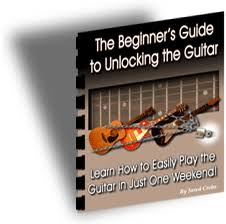Guitar Motivation - Why You Can't Seem To Keep Playing
So you go out and get that new snazzy guitar, have a couple quick jam sessions, and then just can't take it anymore. It seems pretty odd, but you might be like hundreds of other beginning guitarists that become frustrated and can't regain the drive to continue playing.
Frustration can sometimes get the best of us when we expect things to go smoothly like learning the guitar, but sometimes it's more helpful to pinpoint the reason of our failures. Check out these reasons why you might lose your guitar motivation and stop playing.
1. There are not enough hours in a day. With all of the obligations of working and taking care of a family, learning a new talent like playing the guitar can seem like a hassle. However, fitting in even the smallest amount of time like ten minutes per day can stir up a sudden drive that might motivate you to continue even more.
2. You're not making goals. Goals are what can keep you driving forward and looking towards the future. By setting goals for yourself, you now have an obligation to make more time and to achieve a reasonable success that will fuel your guitar motivation.
3. Your goals are not reasonable. You might have set goals, but it's even more detrimental if those goals ask too much of your abilities. Set goals that are small and sequential so you can gain a little gratification each time you reach one that will motivate you to set yet another.
4. You don't play what you enjoy hearing. Sure, you know that scales and practice riffs are essential to improving, but if that's all you attempt to play, it's no wonder you don't enjoy the guitar. Postpone your progress goals every now and then so you can play for actual enjoyment to keep your spirits up.
5. You don't write out what you hope to accomplish. A very powerful motivation technique is to create a personal contract for yourself that states what you promise to accomplish and then signing it. It sounds corny, but your chances of completing your goals are much higher with this tangible item to remind you.
6. You don't want to fail. Failure is one of the worst common fears and it's even prevalent in learning new talents such as the guitar. Just remind yourself that you have nothing to lose, that it's a talent that can stay hidden if you want, and you can go at any pace you desire.
There are a lot of things that can stand in your way of learning the guitar and that's why it might be hard to pick up the instrument again. But, if you learn to throw away your assumptions of how you'll perform and work at your own pace, you can achieve any success you want and gain back some of your guitar motivation. - 18762
Frustration can sometimes get the best of us when we expect things to go smoothly like learning the guitar, but sometimes it's more helpful to pinpoint the reason of our failures. Check out these reasons why you might lose your guitar motivation and stop playing.
1. There are not enough hours in a day. With all of the obligations of working and taking care of a family, learning a new talent like playing the guitar can seem like a hassle. However, fitting in even the smallest amount of time like ten minutes per day can stir up a sudden drive that might motivate you to continue even more.
2. You're not making goals. Goals are what can keep you driving forward and looking towards the future. By setting goals for yourself, you now have an obligation to make more time and to achieve a reasonable success that will fuel your guitar motivation.
3. Your goals are not reasonable. You might have set goals, but it's even more detrimental if those goals ask too much of your abilities. Set goals that are small and sequential so you can gain a little gratification each time you reach one that will motivate you to set yet another.
4. You don't play what you enjoy hearing. Sure, you know that scales and practice riffs are essential to improving, but if that's all you attempt to play, it's no wonder you don't enjoy the guitar. Postpone your progress goals every now and then so you can play for actual enjoyment to keep your spirits up.
5. You don't write out what you hope to accomplish. A very powerful motivation technique is to create a personal contract for yourself that states what you promise to accomplish and then signing it. It sounds corny, but your chances of completing your goals are much higher with this tangible item to remind you.
6. You don't want to fail. Failure is one of the worst common fears and it's even prevalent in learning new talents such as the guitar. Just remind yourself that you have nothing to lose, that it's a talent that can stay hidden if you want, and you can go at any pace you desire.
There are a lot of things that can stand in your way of learning the guitar and that's why it might be hard to pick up the instrument again. But, if you learn to throw away your assumptions of how you'll perform and work at your own pace, you can achieve any success you want and gain back some of your guitar motivation. - 18762
About the Author:
Before you purchase any sort of high-priced guitar lessons, visit How To Guitar Play, to learn Kyle Hoffman's important beginner's tips to start the guitar properly FREE as part of his well-known guitar blog, How To Guitar Tune




